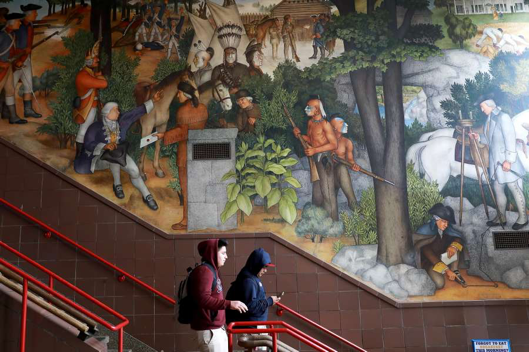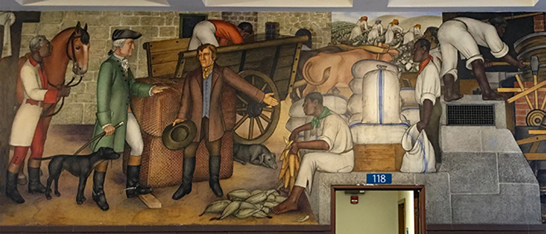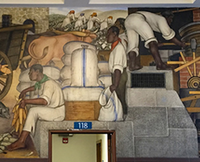
Murals are painted on walls, and they can be a doorway to the past and a window into the present, too. Mural art is big, public, and often controversial. History teachers should have students view, discuss, read and write about these large pieces of art, enhancing their historical understanding in the process.
A case and point is the recent controversy surrounding the mural, Life of Washington, painted on the walls of San Francisco’s Washington High School during the 1930’s by Victor Arnautoff. The San Francisco School Board recently voted 4-3 to cover the mural, against the wishes of a variety of San Franciscans.
The New Deal artist’s portrayal of Washington has been contentious since it was first painted. The mural depicts our Founding Father as a slave holder and complicit in the destruction of Native Americans. Teaching about the origins of our nation and the Founding Fathers is not an easy task. The beginnings of our nation include great accomplishments, but also uncomfortable truths. Mural art, like the Life of Washington, is one way for students to engage with this complicated historical reality.

The first step is to have your students view the mural. You can show them a video of the fresco in the lobby of Washington High School. The footage is embedded halfway down the San Francisco Chronicle article, "Washington high students speak out after summer battle over mural.” And you can see two 360-degree videos, showing each panel of the art work.
As a teacher, your best bet is to show still photos of several of the most controversial panels, those depicting Washington as a slave owner and a second showing white settlers standing over the dead body of a Native American. You can use my Life of Washington Mural Controversy Slideshow and Life of Washington Viewing Guide to project these panels in your classroom.
To help students learn how to analyze a mural, model whole class first. Begin by asking the class the following questions: Who are the main figures in the mural? What activities do you see in the mural? Which aspect of Washington’s life is shown in this panel? Why do you think the artist, Arnautoff, chose to paint this scene? What do you think he was trying to say about Washington? How do the images make you feel?

You can help students by dividing up the main panels into halves, getting them to focus on details in the mural. In addition, you may add background knowledge for students. Did they know that Washington was a slave holder, his Mount Vernon a working plantation?
Next, give students a new panel of the mural. Have them work with a partner, analyzing the images without your help. Give them the same questions. Again, help them by projecting details from the second panel. When you bring the whole class together, ask for partners to share their answers. Provide additional background information about Washington, and the US attitudes and actions toward Native Americans at the founding of the nation.

Secondly, have your students read about the mural and the surrounding debate to learn more. A quick google search will bring up a number of recent news articles about the mural. Or simply use the San Francisco Chronicle article, “SF school board reverses course, decides to save controversial mural” by reporter Jill Tucker. Here is a the Life of Washington Mural Reading Guide I designed for this purpose.
Before students read, be sure they are familiar with the more difficult vocabulary in the article. I’ve identified words that may need defining in the Chronicle article and the Reading Guide. Have students write their own definitions if they know the word. Have them look up word meanings for those they don’t know. Review the vocabulary with the slideshow, so you have front-loaded key words to ensure students can grapple with the reading.
As they read, have students identify the point of view of those critics who would paint over or cover the mural versus those who would like to preserve the mural. The T-chart is a good way for students to list the arguments on both sides of the controversy. Have them identify the critics' and the preservationists' points of view, jotting them down as they read.
Thirdly, once students have read others’ opinions, help students develop their own. Have students find their own voice through discussion, first in pairs and then with the whole class.
Ask them: Why do you think artist Victor Arnautoff painted the Life of Washington Mural, including the images of slavery and the conquest of Native Americans? Do you agree or disagree with the preservationists, who argue the images of slavery and the conquest of Native American tribes depicts a truth about our nation that should be shown to high school students? Do you agree or disagree with the critics who say that the images in this mural are too painful and traumatize students who have to view them everyday at school? Use the Life of Washington Discussion Guide where I’ve provided more student discussion questions.
Finally, have students write. Here is the Life of Washington Mural Writing Prompt I designed for this purpose:
Imagine you were a Washington High School student. You’ve been invited to speak at the next school board meeting. Write a short speech, advising the School Board concerning the Life of Washington mural. Should it be painted over, covered, or should it remain as it is?
After your students have written their speech to the School Board, it might be fun to hear what current Washington High students feel about their mural. Students can read their opinions in the San Francisco Chronicle article by Nanette Asimov, "Washington high students speak out after summer battle over mural.” Or they might enjoy hearing from art professor Dewey Crumpler, who painted murals at Washington High School in 1974, directly in response to Arnautoff’s Life of Washington murals. How were his murals different, and how does he feel about the current controversy?
Bring mural art into your classroom throughout the year. The more murals you show, the better your students will get at identifying the artist’s visual symbols and point of view. Let them debate the mural’s meaning and historical accuracy, deepening their knowledge of the past in the process.
Life of Washington Mural Controversy Lesson Materials by Dave Forrest
- Life of Washington Mural Controversy Slideshow - pptx
- Life of Washington Mural Viewing Guide.pdf
- Life of Washington Mural Reading Guide .pdf
- Life of Washington Discussion Guide. pdf
- Life of Washington Mural Writing Prompt .pdf
Articles
- Tucker, Jill, “SF school board reverses course, decides to save controversial mural” San Francisco Chronicle, August 13, 2019.
- Asimov, Nanette, "Washington high students speak out after summer battle over mural.”, San Francisco Chronicle, August 19, 2019.
- Video Interview with Dewy Crumpler, “Art Professor Dewey Crumpler Defends Victor Arnautoff's WPA Murals", National Coalition Against Censorship, June 17, 2019.